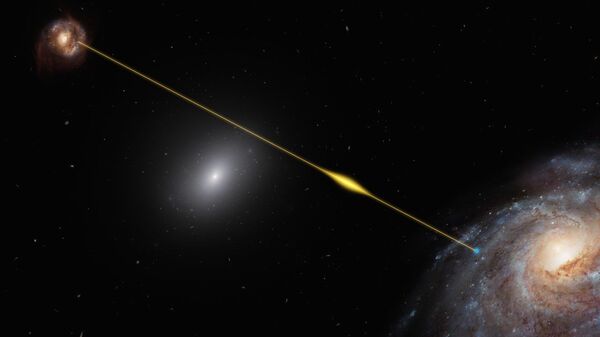Astronomers have traced mysterious, intense blasts of radio energy coming from within our own galaxy.
The origin of the fast radio bursts (FRB) remains largely unknown but observers have now located its origins to a particular celestial object. FRBs tend to only last a fraction of a second but can be 100 million times more powerful than the Sun.
Data taken from telescopes across the world was published in three papers in the journal 'Nature' on Wednesday. An international team of scientists used observations made by technology in Canada, the US, China, and in orbit around the Earth.
To test prominent theories that the origins of FRB are magnetars - stars with a very powerful magnetic field - astronomers tried to position the origin of the bursts within a variety of areas in the sky.
A major cosmic mystery has just been solved.
— New Scientist (@newscientist) November 4, 2020
For the first time, astronomers have tracked a strange blast of radio waves called a fast radio burst back to its source. pic.twitter.com/X6mx5DPzst
This would, in theory, allow researchers to associate FRBs with existing and known space objects and link the bursts of radio energy with astronomical phenomena. This new study is the first to actively connect the FRBs with magnetars, or, at the very least, is a strong indication of their association.
"We calculated that such an intense burst coming from another galaxy would be indistinguishable from some fast radio bursts, so this really gives weight to the theory suggesting that magnetars could be behind at least some FRBs", said Pragya Chawla, a co-author of the study and a senior PhD student with the physics department at Quebec's McGill University.
Paul Scholz, of the Dunlap Institute of Astronomy and Astrophysics at the University of Toronto, said that the findings still do not fully explain known FRBs "given the large gaps in energetics and activity between the brightest and most active FRB sources and what is observed for magnetars, perhaps younger, more energetic and active magnetars are needed to explain all FRB observations".
FRBs remain a mystery, however. Even if astronomers can prove their origin in magnetars, they still need to discover the mechanism through which a magnetar generates an FRB.
“There’s this great mystery as to what would produce these great outbursts of energy, which until now we’ve seen coming from halfway across the universe”, said Kiyoshi Masui, assistant professor of physics at MIT, who led the team’s analysis of FRB brightness.
“This is the first time we’ve been able to tie one of these exotic fast radio bursts to a single astrophysical object".
For the first time, astronomers were able to locate a fast radio burst in the Milky Way, and the closest one ever detected, meaning the mystery of where they come from could be solved.
Due to their short, unpredictable nature, as well as distance, scientists have so far found it difficult to track the origin of the bursts.
It is believed they are formed in some of the universe's most extreme conditions, with explanations ranging from collapsing stars to alien technology.
The bursts of radio energy have been identified as originating from a magnatar, according to the team, who confirmed that the blast would appear like other, more distant FRBs if it had been observed from outside our galaxy – suggesting that some of the other blasts may come from similar objects in other parts of the universe.
The Milky Way FRB was first identified on 27 April, when multiple X-ray and gamma-ray emissions coming from a magnetar at the other side of the Milky Way were picked up by scientists using two North American space telescopes.
The following day, researchers used the two telescopes to observe the area of space where they first picked up the blast known as FRB 200428. The phenomenon is also the first of its kind identified so far to send out emissions aside from simply radio waves.
FRBs were first discovered in 2007, leading to widespread speculation surrounding the origins of such intense energy blasts. Magnetars became the most likely culprit, especially due to theories that their magnetic fields could function like engines, creating and pushing blasts.



